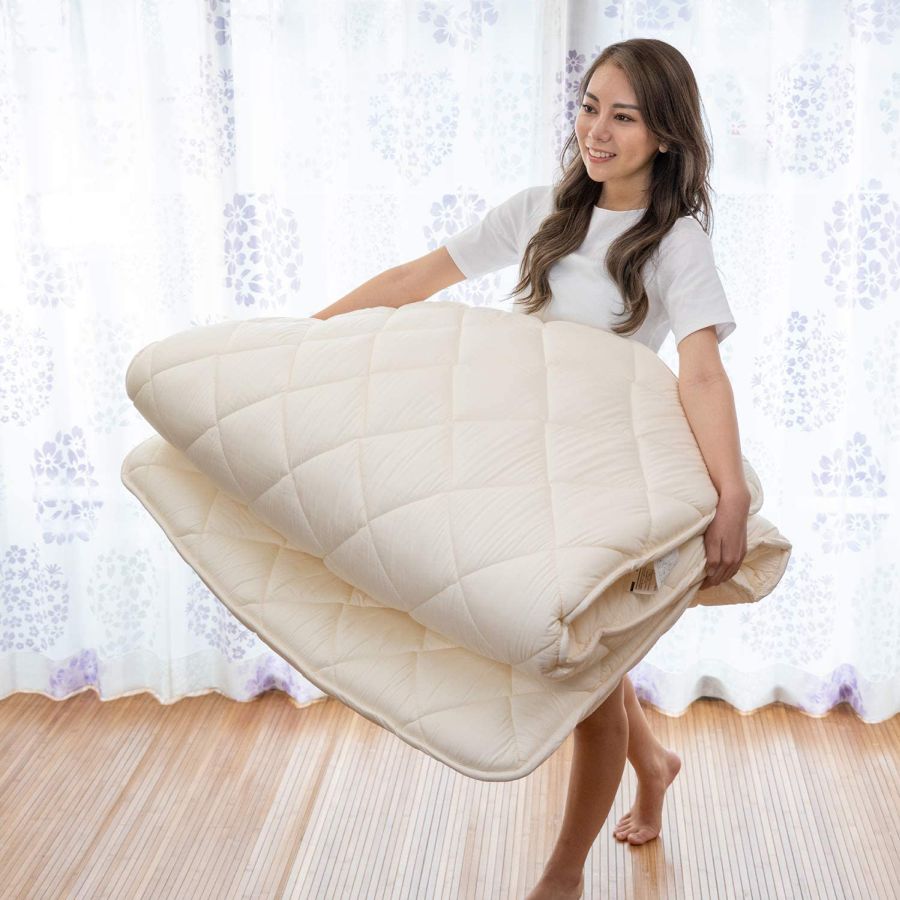What would you choose in a Japanese futon mattress vs regular mattress show-off? They’re both very different products, so it’s not as simple as one being better than the other. Both these products have very compelling reasons to support them.
A Japanese futon isn’t the same as a regular futon mattress most of us are familiar with. We’re going to discuss the original, Japanese futon, which is an entirely different beast.
What Is A Japanese Futon And What Are Its Features?
A futon is the bedding used while sleeping on the ground (or floor) of a house. Japanese futons are slim, soft, and typically filled with cotton to be more comfortable. Called shikibutons in Japan, these beds are quite popular and can be considered to be deep-rooted in Japanese culture.
To be clear, this style of soft bedding isn’t an exclusive Japanese trait. Throughout history, people around the world have been using similar techniques to make soft beds.
However, it is the Japanese Futon (and its name) that caught general interest and popularity. As things stand, the term is applied rather liberally, but that’s okay, considering a Japanese futon is a straightforward setup.
The Anatomy And Design Of A Japanese Futon
These futons are usually rectangular and packed with cotton to be soft and plush. While there is no specific limit on the amount of cotton used, conventional Japanese futons use enough to be three inches thick.
In a conventional Japanese setting, the futon finds its place on a tatami floor (or a straw mat or tatami mat). A slim-profile pillow (makura) and a blanket (kakebuton) complete the set.
Most importantly, the Japanese futon is compact and foldable. In the morning, you can fold the futon to a compact form and store it away. Some people prefer to put their futon in the sun so that it airs out and freshens up.
It is this property that I find the most likable and even useful. In the modern shoebox dwelling, space is at an immense premium.
Everyone needs (and deserves) a comfortable bed,
But beds need a good portion of space, which could be a bit of a problem. A foldable sleeping surface like a Japanese futon would be a godsend in such situations.
Small, compact, and comfortable – just how it’s supposed to be!
Are Japanese Futons Comfortable
Now’s the time for the million-dollar question: Are Japanese futons comfortable?
Buying the right mattress opens up a world of comfort and promises a relaxing sleep. Modern mattresses are carefully engineered (perhaps sometimes over-engineered) to be comfortable. A futon can’t really offer the same comfort as a quality mattress.
However, Japanese futons are comfortable and well-built. You can have a restful night’s sleep on these futons without a problem.
Generally, these futons are thick enough to be comfortable and allow a good sleeping posture.
The Futon And The Japanese Futon
How is the conventional futon different from a Japanese futon?
Well, generally, we see a futon as a pull-out sofa bed. Make a few changes to a sofa, and voila, a futon! In some cases, a futon might have a wooden frame, sometimes called a futon frame. This makes it something similar to a bed frame.
There are plenty of variations available, but the gist remains the same. Our modern futon could very well be a plush mattress placed with other furniture like a sofa, or on a basic frame.
Japanese futons, on the other hand, are more geared towards being folded and stashed away. You’d want them to be portable, compact, and very easy to move.
Flexibility is the key difference here. Our usual futons are thick and made from foam. On the other hand, Japanese futons are thinner and more easily folded.
Then again, the Japanese futon as we know it can sometimes be an umbrella term for several products. Some of these may not be foldable, be overly thick, and use foam in place of cotton. However, for the sake of clarity, we’ll see the Japanese futon in its somewhat traditional definition.
Some Pros And Cons Of Japanese Futons
Here are some of the benefits of Japanese futons:
- They can be folded and stashed away, freeing up space and thus giving you more room.
- There is a belief that these futons are better for your back as compared to mattresses.
- They are durable and easy to manage.
- Being lightweight, they’re easier to maneuver and store.
These futons have some disadvantages too:
- If you prefer a soft and cushy bed, the futons aren’t for you.
- Futons aren’t useful for people who have trouble getting up and down from the floor.
- These futons are thick, so you’ll need generous closet space to store them.
- Cotton or other natural fibers can clump up. However, you can rectify this with simple management.
Japanese Futon vs Regular Mattress – Where Does The Mattress Stand?
The Comfort Comparison
The best mattresses available today are scientifically designed to provide comfort and convenience. Many of them target specific sleep positions, the weight of the user, and even medical needs!
On the other hand, Japanese futons generally take a one-size-fits-all approach. They’re indeed comfortable, but not nearly comparable to a quality mattress.
This becomes even more evident when you need a more specific sleep solution. For example, a heavy person (in terms of weight) who sleeps on their side will not be as comfortable on a futon. On the other hand, a mattress is very likely to have better results.
Construction And Options
In very basic terms, a Japanese futon is a cloth filled with cotton. There are a few more details to it, like proper distribution of the cotton, keeping it all in place, and still making the setup comfortable.
A couple of centuries ago, a mattress would have been pretty much the same. But things changed with the development of the innerspring mattress.
With metal springs providing a bounce, support, and comfort, the mattress took on a new path. There have been (and continue to be) consistent improvements and changes to mattress designs.
Today, you could find a mattress employing innersprings, pocket springs, memory foam, latex foam, regular foam, or a hybrid that puts together these technologies.
Most quality mattresses work to support your body weight and distribute it so well that you might as well feel like you’re floating on clouds. They’re well made and can support a variety of requirements and sleeping preferences.
Without a doubt, mattresses hold the upper hand in this category.
Portability And Space
Time for the Japanese futon to shine in its comparison with the mattress!
Modern mattresses are massive. Most of them are thick, measuring between 8 to 14 inches and can be quite heavy. This is especially true for innerspring mattresses, which have a metal framework. Even foam mattresses get remarkably heavy.
Regular mattresses remain difficult to move. It’s near impossible for a single person to move them and difficult even when you have a few people available.
With that large mattress thickness also comes a lack of flexibility. Many of them will have some flexibility, like adjustable beds, but it’s thoroughly limited. Most mattresses offer no flexibility at all.
Japanese futons are the exact opposite of this scenario. They are immensely easy to move and very flexible where it comes to the use of space. Being lightweight, the futons are easy to move. You could move them wherever you like.
Fold or roll the futon, and you’re good to go!
For homes with a small living space, you could free up space by folding the futon and placing it in a closet. That way, the bedroom transforms into a living room and you get more room for activities.
Since the futon is lightweight and flexible, you could place it wherever you like it, as per your will. Changing its location is as easy to accomplish.
The Cost Factor, Because Money Talks
A lot of factors go into deciding what we want to purchase. Nevertheless, at the end of the day, it is the budget that call the shots.
Futons and mattresses both vary in size and quality options, as does the price. Therefore, this is more a general comparison rather than a more specific approach.
In this comparison, I have used the term “quality mattress” several times. So, it makes sense that if we’re talking of the best of mattresses, we also consider their price.
Good mattresses are expensive. A few hundred dollars come easy. You can as easily expect to spend a few thousand dollars on a quality mattress.
On the other hand, futons are relatively cheap. A good quality Japanese Futon is often lower than a couple hundred bucks. And even that’s when you’re browsing at the top of the line.
Coolest Japanese Futon Mattresses For 2021
1. Luxton Home Japanese Shiki Futon Foldable Mattress
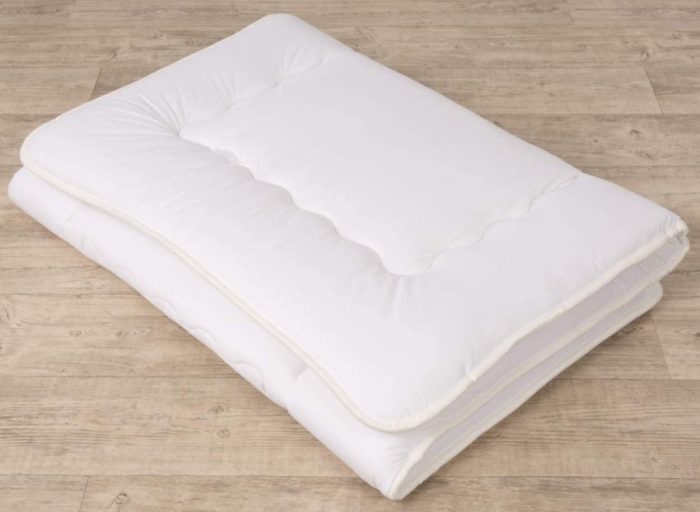
Luxton Home Japanese Shiki Futon Foldable Mattress is available in several sizes. It is thinner than the usual Japanese Futon mattress, but that’s by design. The company says that reduction of padding and sleeping on a firm surface leads to better spine alignment and lower back pains.
The futon has a cotton filling and the fabric is cotton as well. It arrives compressed, so the company suggests allowing up to three days for the Futon to expand completely.
As a thin futon, it can also be used as a yoga mat or meditation mat. It’s available in many sizes, so there’s plenty of options to pick from.
2. Grey Constellation Japanese Floor Futon Mattress
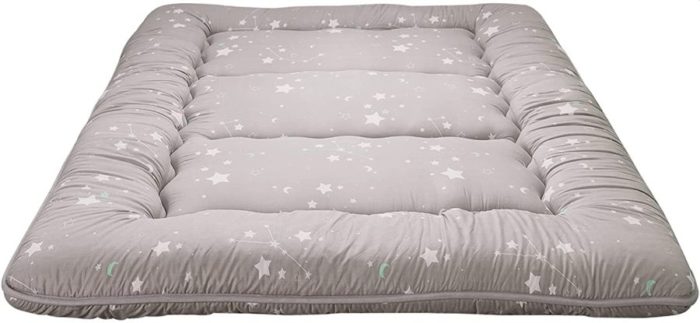
Filled with microfiber cotton, this futon uses touches of memory foam to add more comfort to your sleep. The combination takes the mattress thickness to four inches, giving it a good depth.
The memory foam layer in the futon is about 2-inches thick. It is surrounded on both sides by layers of cotton. This combination makes the futon fairly comfortable. Apart from adding support to the user while sleeping, this layer of memory foam also benefits the mattress. Its presence won’t allow the mattress to collapse quickly.
The downside to this approach is that folding and managing the futon becomes more difficult. It’s also heavier and requires more effort to move.
This is a versatile futon and can also be used for purposes like camping or the guest room.
3. EMOOR Japanese Floor Futon Mattress CLASSE
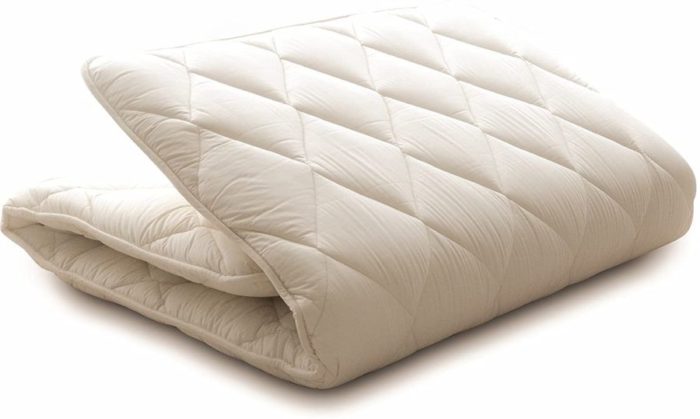
Another comfortable but thin futon, EMOOR Japanese Floor Futon Mattress CLASSE deserves your attention. Though thin, this too is a three-layer mattress. A firm pad is placed in the middle of the futon to stop it from crashing. Then, it is covered in a plush film of quilted soft fiberfill pads.
Though available in several sizes, the futon only has a single color to choose from. And considering how elegant it looks and what a clean finish it has, that single color is more than enough!
The logic for having a flat futon is the same – sleeping on a hard surface is expected to make your back feel better. If that logic doesn’t suit you, there’s always the option to take a pick from the best mattresses for back pain.
4. Maxyoyo Futon Mattress Foldable Bed
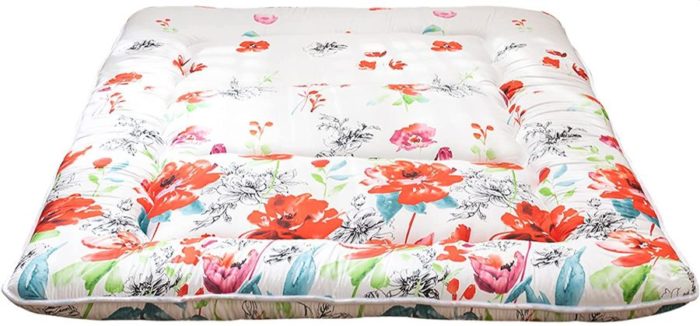
Maxyoyo Futon Mattress Foldable Bed takes something of a traditional approach. This is a thick Japanese futon, touching the usual 4-inch thickness. To keep it suitable for the modern sleeper, it has a touch of firmness added with the use of memory foam.
The futon has a layer of memory foam in the center sandwiched between two layers of microfiber cotton. Put together, this setup keeps it comfortable and firm.
Of course, it is good for usual requirements like camping and outdoor use as well. Although the use of memory foam is a departure from the traditional way of the futon, it is a suitable and useful choice for the modern age.
The futon is available in several color and size options, so you’ll have no trouble finding one that’s the right fit for you.
5. FULI Japanese Traditional Shiki Futon (shikibuton) High Grade Floor Mattress
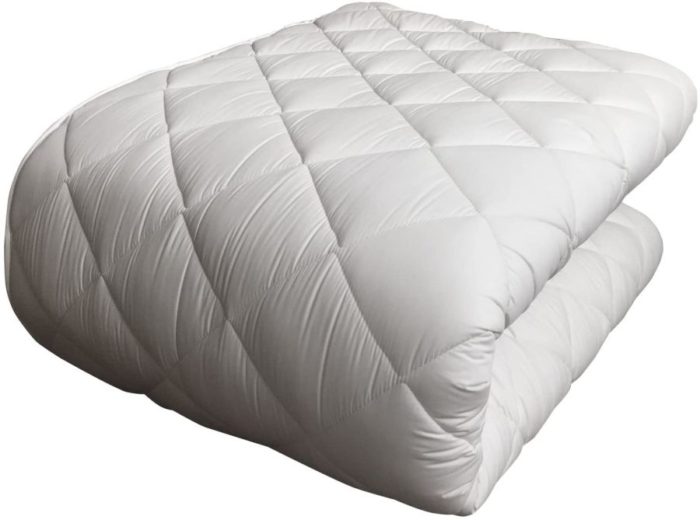
FULI Japanese Traditional Shiki Futon (shikibuton) High Grade Floor Mattress is made in Japan and takes a more authentic approach to the futon. Made with a premium touch, it is soft, rollable, and compact.
The fabric used is cotton, though the filling employs polyester and polyurethane. Skipping the memory foam layer means this mattress sacrifices a bit of comfort. But then again, the conventional futon isn’t supposed to have a layer of memory foam.
Fuli’s quality craftsmanship gives this premium futon a worthy and excellent flavor. You can roll it, store it, and use it much like the conventional Japanese futon. And that, in my opinion, is the biggest advantage this futon has over mattresses or other futons.
6. MIINA Japanese Traditional Igusa (Rush Grass) Tatami Mattress
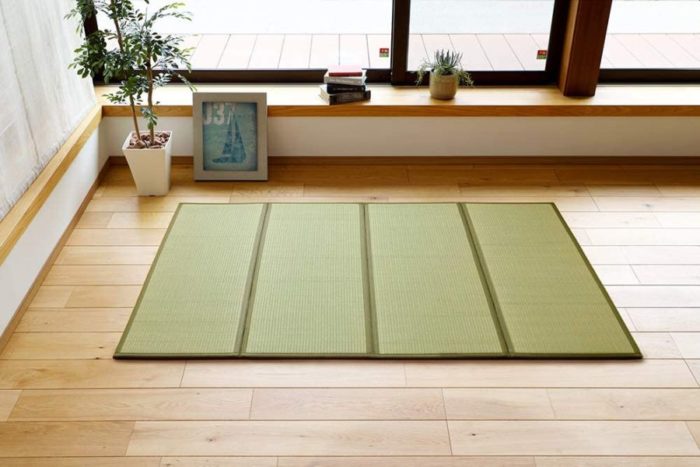
Japanese futon mattresses aren’t intended to go on the bare floor. It is usually recommended to place a Tatami mat under the mattress. This provides it with some insulation as well as a better base.
The Tatami Mat is lightweight and thin. It’s only 0.4-inches in thickness and has panels that make it easily foldable and portable. While it has a touch of tradition, it also subtly departs from the conventional style.
Tatami Mats made from rush grass are generally built to be thick and heavy. By taking the thin and light route, it adds to the usability. After all, modern users have better ways for insulation and don’t need a thick layer of grass to keep the cold away.
In any case, this mat is a great companion to futon mattresses.
Some Tips To Make The Best Of Your Japanese Futon Mattress
Here are some ideas to use and make the best of your futon. Do also consider the conventional style and see the changes for Japanese futon mattress vs regular mattress recommendations.
The conventional futon is going to be firm. There might be times when you want it to be softer, more pliable, or want conventional care instructions.
We’ve got you covered.
Making The Futon Softer
Got the futon but don’t feel comfortable with how firm and compact it feels?
You can use these ideas to make the futon softer and to help with the transition.
The simplest idea is to put a mattress topper on the futon mattress. Toppers provide a plush surface for mattresses, and they can perform their duties for futons too!
If you need a different touch, think of putting in an air mattress above or below the futon. This mattress will cover the pressure and relieve some of the firmness from the futon.
Take A Closer Look At The Futon’s Constituents
Any futon is going to be only as good as its filling. The stuffing will also decide how easy to fold and compact the futon is.
Cotton fiber and polyester fiber are the most common stuffing. They both have their advantages and disadvantages. Sometimes, plush futon mattresses add a block of memory foam to the mix.
Memory foam gives the futon more firmness and support. You might also find it more comfortable, though it will need more effort to fold and pack away.
Whether you choose to go for the conventional shikibutons or the more plush futon mattresses, remember to take a closer look at the constituents.
Care Instructions For Futon Mattresses, Japanese Or Regular
There are simple ways and practices one needs to follow to take good care of their mattresses. Unlike the usual regular mattresses, futons don’t really get a mattress protector. So, you’ll have to be more proactive as their “protector”!
Clean any liquid spill on the mattress immediately. Also, vacuuming the mattresses regularly will keep them in a good shape.
One thing often stressed for maintenance of Japanese Futon Mattresses is the need to air them. Put them up on a clothesline or a similar setup, and let the mattress soak in the sun and the wind. This practice will keep it hygienic, reduce odor buildup, and keep the mattress fluffy.
You could give regular mattresses and futons similar treatment, but they aren’t as easy to maneuver or air. In these cases, spot-cleaning and vacuuming is a better method.
It won’t be possible to wash your Japanese futon mattress, so regular vacuuming, airing, and spot cleaning as necessary are important.
This prevents moisture buildup, which can cause the growth of fungus and bad odor in the mattress. Air drying will also let dust and dander fall off the mattress and keep it better smelling and more comfortable.
Comparing The Japanese Futon Mattress With Regular Mattresses
Going through the Japanese futon mattress vs regular mattress setup is a convenient pick. They are different products with clear USPs (unique selling points). Japanese futons are comfortable, but they’re designed to be thin and firm. They aren’t as thick and heavy as regular mattresses.
Japanese futons are easy to roll or fold and stow away when not in use. That way, you can free up space when necessary and have more open areas in compact dwellings with little room to spare.

